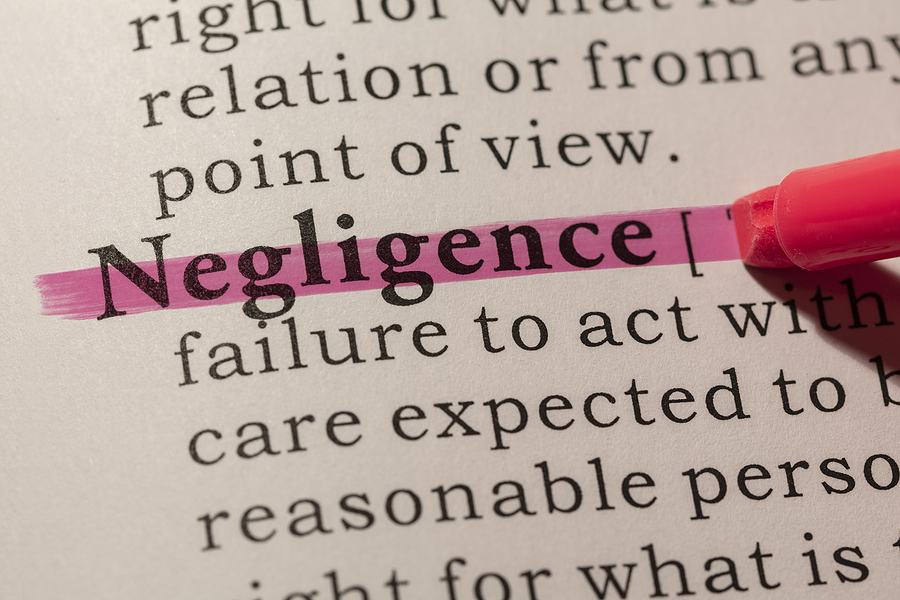Tort is a legal term that describes a wrongful action (or failure to act) that causes another person harm. An injured person (the plaintiff) has a civil claim against the at-fault party (the defendant) who commits a tort. Tort law provides a way for the plaintiff to recover compensation from the defendant. Injuries don’t have to be physical injuries. In tort law, injury refers to physical, emotional, and financial injuries. A plaintiff who wins their case can recover damages—monetary compensation for their injuries.
There are three types of torts: Intentional torts, strict liability torts, and negligent torts. An intentional tort is when a defendant commits an act meant to harm someone, such as assault, trespassing, or kidnapping. A strict liability tort is when a company harms someone with their product or services, such as when a company manufactures and sells a defective product. Negligent torts are the most complicated – we’ll discuss them in more detail, below.
Negligent Torts
A negligent tort happens when a plaintiff suffers injuries because of the defendant’s unreasonably unsafe actions or failure to act. While the plaintiff must file a claim in civil court to recover damages, the defendant might face criminal penalties as well, depending on the tort.
For example, when a defendant causes a car accident, the plaintiff can seek damages from the defendant in a negligent tort lawsuit. However, if the defendant drove under the influence of drugs or alcohol when they caused the accident, a criminal court might also prosecute the defendant. These are two separate cases, and neither case’s outcome directly affects the other.
The law describes three types of negligent torts:
Negligence
The defendant legally owes the plaintiff a duty of reasonable care. That is, the law expects defendants to behave reasonably. For example, everyone must drive in a reasonably safe manner.
If the defendant breached their duty of reasonable care, they are legally responsible for the injuries they cause. In the car accident example, if the defendant was speeding or otherwise failed to follow the rules of the road, they breached their duty to the plaintiff to drive safely and reasonably, and they are therefore legally responsible for causing the accident that led to the plaintiff’s injuries.
Negligence Per Se
A negligence per se tort is a little different from a standard tort case, in that it applies when there is a specific law that creates a legal duty that protects a specific class of people.
For example, Nevada has laws against driving under the influence of drugs or alcohol. These laws protect people from drunk driving injuries. A defendant violates the law by driving with a blood alcohol of 0.08 or higher. So, if clear evidence shows the defendant was under the influence at the time of the accident, the plaintiff can usually prove that the defendant committed negligence per se.
Res Ipsa Loquitur Negligence
In this type of negligent tort case, the plaintiff very clearly did not contribute to causing their own injuries. Res ipsa loquitur means “the thing speaks for itself.” The law considers certain personal injury cases to be res ipsa loquitur negligence.
To have a res ipsa loquitur negligent tort claim, the plaintiff must prove that the type of accident they experienced would not happen unless the defendant was negligent, that the defendant was the sole cause of the accident, and that the plaintiff did not contribute to the accident.
One example of res ipsa loquitur negligence is a medical malpractice case where the surgeon operates on a patient and leaves a foreign object inside their body that causes an infection. Clearly, the patient had no part in causing the infection, and only the surgeon could have left a foreign object in the patient’s body, leading to the patient’s injuries.
Recovering Damages After a Negligent Tort
The amount and type of damages a plaintiff might recover by winning a negligent tort lawsuit depends on the injuries the plaintiff suffered, whether the plaintiff lost a loved one because of negligent behavior, or if gross negligence (extremely negligent behavior on the part of the defendant) was involved.
Compensatory Damages
A plaintiff generally sues the defendant to recover compensatory damages, which is monetary compensation to reimburse the plaintiff for their accident-related losses. A plaintiff usually asks for a combination of economic damages, which are reimbursement for costs related to the accident, along with non-economic damages, which are reimbursement for intangible losses, such as pain and suffering.
Examples of economic damages include past and estimated future medical expenses and lost wages, reimbursement for destroyed personal property, and funeral expenses.
Examples of non-economic damages include loss of use of a body part or bodily function, loss of quality of life, loss of companionship, loss of consortium, inconvenience, scarring, disfigurement, amputation, and paralysis.
Punitive Damages
A court will only allow a plaintiff to recover punitive damages if they can prove that the defendant’s actions were grossly negligent. For example, a court might consider excessive speeding while evading a police officer to be gross negligence. The court orders punitive damages to punish the defendant, rather than to make the plaintiff whole again.
It is in your best interest to seek a personal injury lawyer to review your case to see which damages you should pursue, as well as make certain you identify everyone who owes you compensation for your injuries. This ensures you recover the highest compensation and the best treatment needed to recover from an accident not of your making.


